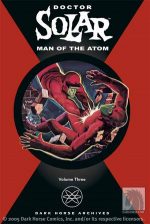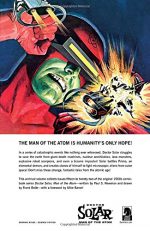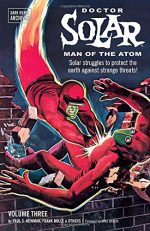


By Paul S. Newman, Dave Wood, Frank Bolle, Al McWilliams, George Wilson & various (Dark Horse Books)
ISBN: 978-1-59307-374-9 (HB) 978-1-61655-354-8 (TPB)
The comics colossus known as Dell/Gold Key/Whitman had one of the most complicated publishing set-ups in history, but that didn’t matter one iota to the kids of all ages who consumed their vastly varied product. Based in Racine, Wisconsin, Whitman had been a crucial part of the monolithic Western Publishing and Lithography Company since 1915, drawing upon commercial resources and industry connections that came with editorial offices on both coasts (and even a subsidiary printing plant in Poughkeepsie, New York).
Another connection was with fellow Western subsidiary K.K. Publications (named for licensing legend Kay Kamen who facilitated extremely lucrative “license to print money†merchandising deals for Walt Disney Studios between 1933 and 1949).
From 1938, Western’s comicbook output was released under a partnership deal with a “pulps†periodical publisher under the umbrella imprint Dell Comics – and again those creative staff and commercial contacts fed into the line-up of the Big Little, Little Golden and Golden Press books for children. This partnership ended in 1962 and Western had to swiftly reinvent its comics division as Gold Key.
As previously stated, Western Publishing had been a major player since comics’ earliest days, blending a huge tranche of licensed titles such as newspaper strip, TV and Disney titles (like Nancy and Sluggo, Tarzan, or The Lone Ranger) with home-grown hits like Turok, Son of Stone and Space Family Robinson.
In the 1960s, during the camp/superhero boom the original adventure titles expanded to include Brain Boy, M.A.R.S. Patrol, Total War (created by Wally Wood), Magnus, Robot Fighter (by the incredible Russ Manning) and – in deference to the atomic age of heroes – Nukla and another brilliantly cool and understated thermonuclear white knight…
Despite supremely high quality and passionate fan-bases, Western’s pantheon never really captured the media spotlight of DC or Marvel’s costumed cut-ups, and eventually – in 1984 – the West Coast crew closed their comics division, having lost or ceded their licenses to DC, Marvel and Charlton.
As a publisher, Gold Key never really “got†the melodramatic, breast-beating, often-mock-heroic Sturm und Drang of superheroes – although for a sadly-dwindling number of us, the understated functionality of Silver Age classics like Magnus, Robot Fighter or remarkably radical concepts of atomic crusader Nukla and even the crime-fighting iterations of classic movie monsters Dracula, Frankenstein and Werewolf were utterly irresistible.
The sheer off-the-wall lunacy of features like Neutro or Dr. Spektor I will save for a future occasion…
The company’s most recognisable and significant stab at a superheroes was an understated Atomic era paladin with the rather unwieldy codename of Doctor Solar, Man of the Atom. He debuted in an eponymous title cover-dated October 1962 – Happy Anniversary! – sporting a captivating painted cover by Richard M. Powers which made it feel like a grown up book rather than a simple comic. With #3, George Wilson took over the iconic painted covers: a glorious feature that made the hero unique amongst his costumed contemporaries…
By the time of this third collection – also available in hardback, but tragically not in any digital editions I know of – originator Paul S. Newman (A Date With Judy; The Lone Ranger; Turok, Son of Stone; I Love Lucy and countless more) had all but moved on – despite what the credits here say. The issues included here are Doctor Solar, Man of the Atom #15-22 and span December 1965 to January 1968 and he only wrote one of them.
Golden Age all-star Dick Wood (Sky Masters of the Space Force; Crime Does Not Pay; The Phantom; Mandrake the Magician; Flash Gordon and countless others) was primarily tapping the keys for this period, but Frank Bolle (The Twilight Zone; Boris Karloff’s Tales of Mystery; Flash Gordon; The Heart of Juliet Jones) was still providing slick understated visuals for one of the most technically innovative and conceptually spectacular series on the stands. That changed with #20, when Alden “Al†McWilliams (Danny Raven/Dateline: Danger; Star Trek, Flash Gordon; Twilight Zone; Buck Rogers; Justice Inc.; Star Wars and so much more) took over, drawing and inking to the end of this volume (and the first tale in the next one).
The Supreme Science Hero was born when a campaign of sabotage at research base Atom Valley culminated in the death of Dr. Bentley and accidental transmutation of his lab partner Doctor Solar into a (no longer quite) human atomic pile with incredible, impossible and apparently unlimited powers and abilities. Of course, his mere presence is lethal to all around him until scientific ingenuity devises – with dutiful confidantes girlfriend Gail Sanders and mentor Dr. Clarkson – a few brilliant work-arounds…
Following a Foreword from Mike Baron detailing those faraway times and concentrating on real world nuclear near-things, the atomic adventuring resumes with the latest ploy by evil mastermind Nuro, who wants the monopoly on atomic science and global decision making.
Written by Wood and limned by Bolle, ‘Doomsday Minus One Minute Parts I & II’ comes from the end of 1965 and finds Atom Valley boffin Dr. Lamson cracked under the Cold War pressure. He devises a doomsday trigger to fire every thermonuclear weapon at once… just to end the appalling anticipation…
After failing at every stage to avert armageddon, Solar secures a unique method of time-travel to save the day and all the rest to come…
Cover-dated June 1966 and on newsstands from March onwards thanks to Gold Key’s byzantine publishing schedules, ‘The War of the Suns Pts I & II’ was #16’s main feature and actually by Newman & Bolle. Here Nuro’s espionage delivers the deadly methodology of building miniature suns, and enables him to unleash hell on Earth from close orbit. The solution? Build another sun and have Solar use it to destroy the hellish invader. What could go wrong?
Wood & Bolle reunited in #17 (September 1966) for some traditional monster marauding as Nuro combines weird science and Alaskan volcanoes to build ‘The Fatal Foe.’ Elemental colossus Primo rampages towards Atom Valley and an eventual but titanic ‘Duel to Disintegration’.
Although a diabolical master of mayhem, Nuro’s continued failures clearly began to grate with his lieutenant Uzbek, who increasingly squabbled and gaslit the mastermind’s faceless android protégé Orun. In #18 (December 1966) with open warfare brewing between flunky and automaton, their fiendish overlord returned to brainwashing, targeting all Atom Valley techs and boffins with mind-control scorpions in ‘The Mind Master Parts I & II’. He sought the secret identity of the Man of the Atom but almost brought about his own destruction, further strengthening Uzbek’s thoughts of rebellion…
Bolle bowed out with #19 (April 1967) as Nuro modified his metal minion to resemble the Atomic Adventurer and attempted to blacken his enemy’s name and reputation in ‘Solar vs Solar’ and its action-packed conclusion ‘Only One Shall Survive’. The tale ended on a cliffhanger with Solar defeated, trapped and wired into the villain’s secret HQ, providing atomic energy to fuel Nuro’s next vile venture…
Cover dated July, #20 saw Al McWilliams join Wood as ‘Atomic Nightmares Parts I & II’ revealed how the hero brilliantly engineers his escape, but only by inadvertently creating a menace as great as Nuro. Almost as portentous is the debut of Gail’s nephew Hamilton Mansfield Lamont: a teen super-genius with as many secrets as ideas…
As he settles in at Atom Valley, #21 (October 1967) aliens considering an invasion of Earth offer a ‘Challenge from Outer Space Parts I & II’ which needs all Solar’s power plus a helping hand from the kid to foil, before the volume closes with an epic clash and monumental upgrade in menace.
Cover-dated January 1968, Wood & McWilliams reveal ‘The Two Lives of Nuro’ as Uzbek sells out, delivering the mastermind’s location to Interpol. With Solar leading the charge in a blazing battle, the villain finally falls. Dell/Gold Key infamously never joined the Comics Code Authority, and consequently their titles always had a perfectly understandable body count in situations where equivalent Marvel or DC characters would generate the odd skinned knee or sprained ankle in already empty and “condemned†buildings…
Here, however, as carnage mounts and justice closes in, Uzbek is brutally killed before the would-be world-conqueror “commits suicide†while transferring his malevolent personality into his robot for ‘The Strange Death of Nuro’. The countless casualties climb even further when Solar brings the body and the android back to Atom Valley and the dormant motionless mandroid revives…
The epics end for now with ‘Biographies’ of Newman, Bolle and cover artist Wilson, as this charismatic collection offers potently underplayed and scientifically astute (as far as the facts of the day were known) adventures blending the best of contemporary film tropes with the still fresh but burgeoning mythology of the Silver Age superhero boom. Enticingly restrained and understated, these Atom Age action comics offered a compelling counterpoint to the hyperbole of DC and Marvel and remain some of the most readable thrillers of the era.
These tales are lost gems from a time when fun was paramount and entertainment a mandatory requirement. This is comics the way they were and really should be again…
DOCTOR SOLAR®, MAN OF THE ATOM ARCHIVES Volume 3 ® and © 2014 Random House, Inc. Under license to Classic Media, LLC. All rights reserved.
